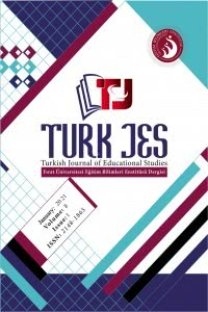ORTAÖĞRETİM ÖĞRENCİLERİNİN ÖĞRENME STİLLERİNİN BELİRLENMESİ (ANKARA İLİ, HACI ÖMER TARMAN ANADOLU LİSESİ ÖRNEĞİ)
Özet Araştırmanın genel amacı öğrencilerin sahip oldukları öğrenme stillerini belirlemektir. Bu genel amaç çerçevesinde öğrencilerin öğrenme stillerinin cinsiyet, anne-baba öğrenim durumu, evde internet ve çalışma odasının bulunması, destek eğitimi alma değişkenleri açısından anlamlı bir farklılık gösterip göstermediği incelenmiştir. Araştırmanın çalışma evrenini, 2015-2016 eğitim-öğretim bahar yarıyılında Ankara ili Çankaya ilçesinde bulunan Hacı Ömer Tarman Anadolu Lisesi 9.sınıfta öğrenim gören 156 öğrenci oluşturmaktadır. Tüm 9. Sınıf öğrencileri araştırmaya dâhil edilmiştir. Araştırmada öğrencilerin öğrenme stillerini belirlemek amacıyla Otrar (2006) tarafından geliştirilen 99 maddelik, “Marmara Öğrenme Stilleri Ölçeği” kullanılmıştır. Verilerin çözümlenmesinde aritmetik ortalama, bağımsız gruplar t-testi, Mann Whitney U testi, tek yönlü varyans analizi ve Kruskall Wallis H testleri uygulanmıştır. Araştırma sonucunda öğrencilerin sosyal etkileşimle çalışma tercihlerinin yüksek olduğu, dokunsallık, görsellik öğrenme stilinin işitsel stile göre daha çok tercih edildiği belirlenmiştir. Ayrıca öğrencilerin sebatkârlık tercihlerinin yüksek olduğu, otorite eşliğinde çalışmayı tercih etmedikleri ve daha çok öğleden sonra ya da akşamları çalışmayı tercih ettikleri görülmüştür.
Anahtar Kelimeler:
Öğrenme, öğrenme stilleri, orta öğretim
A Study To Identify Learning Styles Of Secondary Education Students (Ankara Province, Hacı Ömer Tarman Anatolian High School Sample)
General objective of the study is to identify students’ learning styles. Within the scope of this purpose, it is researched if the learning styles of the students differ considerably according to gender, parents’ educational background, having a study room and internet access, and taking supportive courses variables. Target population of the study comprises of 156 students who study at 9th grade of Hacı Ömer Tarman Anatolian High School in 2015-2016 educational year spring term. In the research, all 9th grade students are included in the study, sampling is not done. “Marmara Learning Styles Scale” which is developed by Otrar (2006) and consists of 99 entries is used to identify learning styles of the students. Packaged software is utilized in analyzing the data and; arithmetic mean, independent samples t-test, Mann Whitney U test, Kruskall Wallis H test and one-way analysis of variance are applied. Results of the study indicates that students prefer learning with social interaction, tactile and visual learning comparing to the auditory learning. It is also observed that students’ preferences of perseverance are high, they don’t like to study in company with an authority figure and they would rather study in the afternoon or in the evening.
Keywords:
: Learning, learning styles, secondary education,
- ISSN: 2458-8210
- Başlangıç: 2014
- Yayıncı: Fırat Üniversitesi
